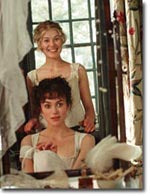Nightgowns and Underthings
Yes, he had no engagement at all for to-morrow; and her invitation was accepted with alacrity. He came, and in such very good time that the ladies were none of them dressed. In ran Mrs Bennet to her daughter's room, in her dressing gown, and with her hair half finished, crying out, "My dear Jane, make haste and hurry down. He is come -- Mr Bingley is come. -- He is, indeed. Pride and Prejudice
 Shift
Shift
This garment, basic for both men and women, was straight cut, usually knee length, and had the elbow length sleeves set straight into the shoulders. The women wore their shifts under their corsets, and in the second half of the 17th and 18th centuries the frills at the low cut neckline at at the elbow were intended to show in the openings of the dress. Most was of white linen, easily washable. There was little change in cut or material until the last quarter of the 19th century.
 Chemise
Chemise
Chemise is the French word for shirt. Since the Rococco period this has been the term for an under garment with short sleeves; somewhat later (1785-1800) the shirt type garment, the chemise, was the fashion. The name was transferred to a day dress of similar cut.
Nightshirt
It was first found in the late Middle Ages under the term bedshirt; until then people had either slept naked or had kept on their day clothes. The first nightshirts were very capacious, otherwise they were by and large similar to a day shirt. In general the nightshirt prevailed first in the 19th century, in many countries later. At night, Women often wore a night jacket over the day chemise.
 Dressing Gown, Undress Gown, Nightgown, Négligé
Dressing Gown, Undress Gown, Nightgown, Négligé
All of these were terms for a comfortable house garment. In the 17th and 18th centuries it was known as a nightgown and worn by both sexes as in informal house-dress. It was originally based on the Far Eastern kimono or banyan. Men's dressing gowns preserved their classical style; they were made of silk or flannel and reached to the calves. They were worn for morning toilette, including breakfast. Women's dressing gowns were mostly long, so that they covered the length of the nightdress. According to fashion expert Cathy Decker, During the Regency,"Undress" meant simply casual, informal dress. It was also called "dishabille" or "deshabille," the French word for the same type of dress. Another clue is anything "negligently worn" or "à la négligé" is probably either undress or designed to resemble closely undress. Undress is the sort of dress to be worn from early morning to noon or perhaps as late as four or five, depending on the engagements one had. Compared to half dress and full dress, undress was usually more comfortable, more warm, more casual, and much cheaper in cost.  The male equivalent to the dressing gown was the Banyan. The Banyan was a Persian inspired, Asian style robe that was worn by fashionable men, at home. During the day it could be worn over a shirt/vest/breeches combination-- a warm alternative to a coat or jacket in a drafty house. At night it would be worn, like a bathrobe, over the nightshirt, until retiring to bed. It would not have been worn to bed. It was the precursor to the Victorian dressing gown. Well-to-do, intellectual men, such as Ben Franklin, often had themselves painted "at home" in their Banyans, instead of full formal dress.
The male equivalent to the dressing gown was the Banyan. The Banyan was a Persian inspired, Asian style robe that was worn by fashionable men, at home. During the day it could be worn over a shirt/vest/breeches combination-- a warm alternative to a coat or jacket in a drafty house. At night it would be worn, like a bathrobe, over the nightshirt, until retiring to bed. It would not have been worn to bed. It was the precursor to the Victorian dressing gown. Well-to-do, intellectual men, such as Ben Franklin, often had themselves painted "at home" in their Banyans, instead of full formal dress.

Leave a comment
This site is protected by hCaptcha and the hCaptcha Privacy Policy and Terms of Service apply.